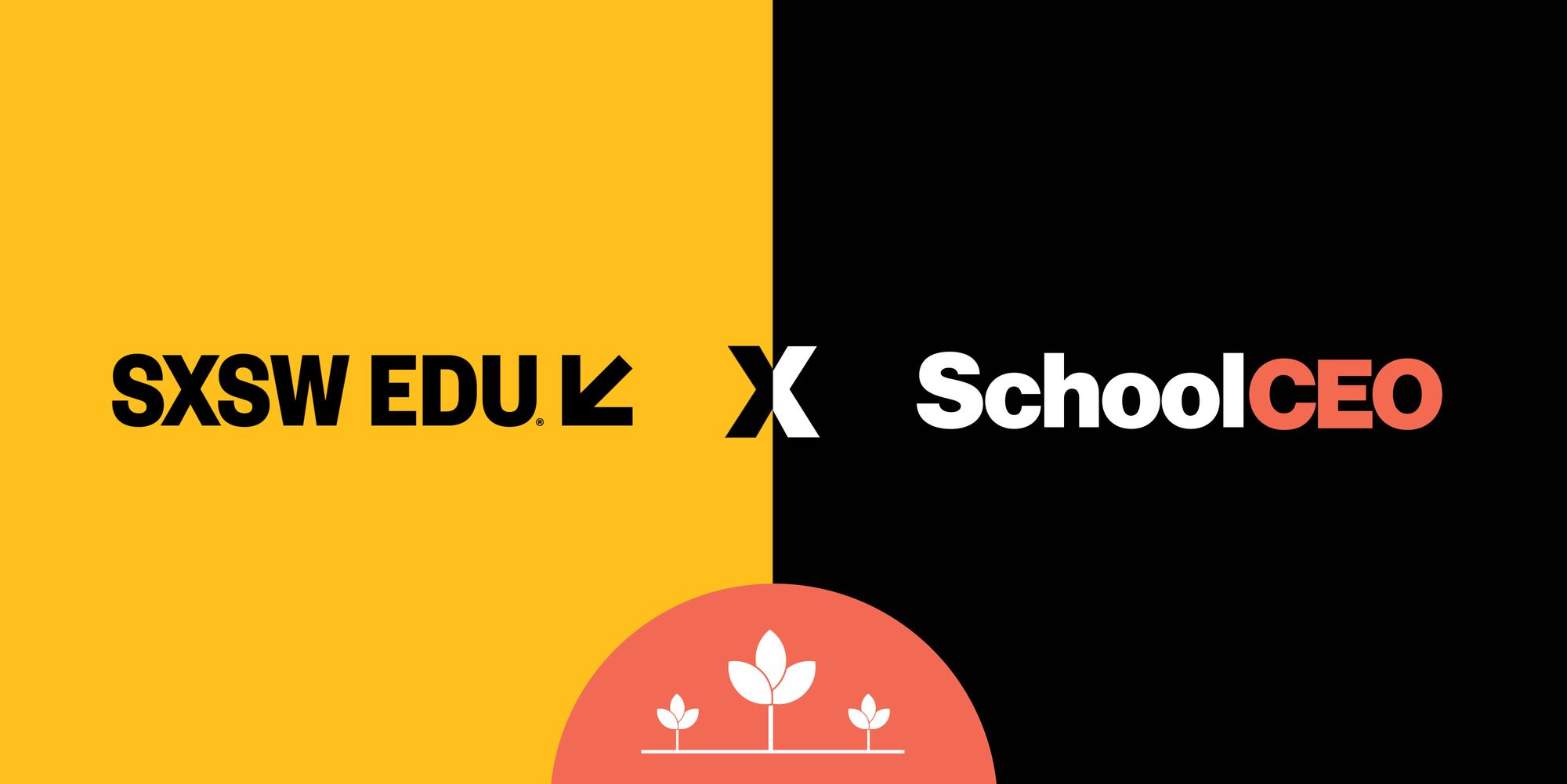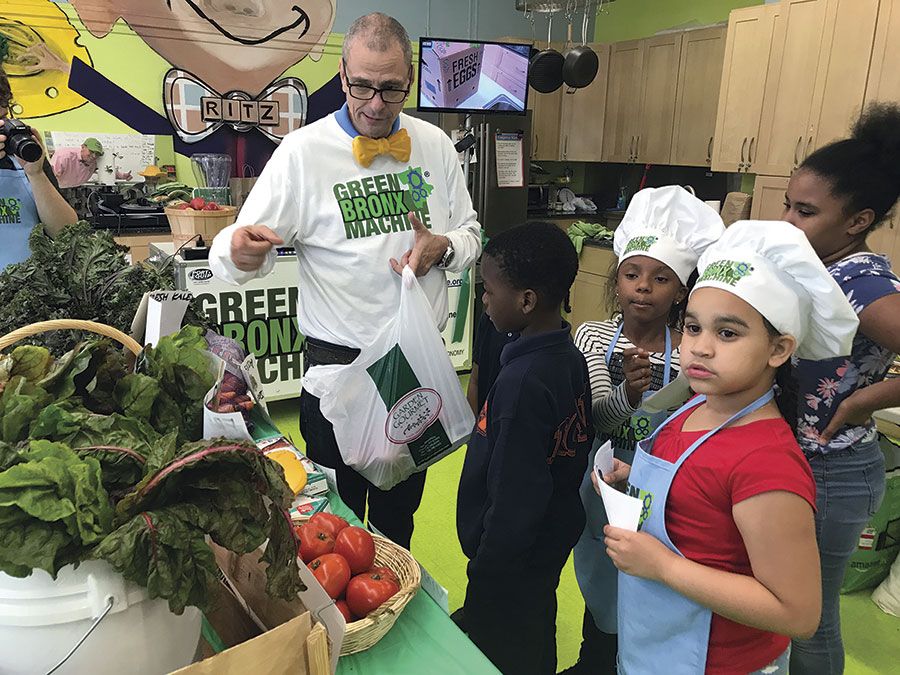SXSW EDU x SchoolCEO: Farming in the Classroom
Green Bronx Machine founder Stephen Ritz tells us how urban farming can feed hearts, minds, and communities everywhere.

“No one is the luckiest guy on earth more than I am,” Stephen Ritz tells us with a big smile. He’s wearing a black T-shirt that reads “Sustainable Gangster” in bright green letters and a cowboy hat made of what we hope is fake cheese. Ritz is a lifelong educator and the founder of Green Bronx Machine—an urban farming nonprofit he started in his classroom that has now become a global phenomenon. “It’s changed everything for me,” he says.

Ritz grew up wanting to be a pro basketball player. “This is the last year I’m willing to accept a call from the NBA!” he jokes. But he found his true calling off the court. “I started my first year teaching at South Bronx High School—it was the only standing building within an eight-block radius in the poorest congressional district in America. That’s where I found out I have a gift with children and that I love teaching.”
Ritz eventually left NYC, overwhelmed by the “sheer desperation that was life in urban America in the late ‘80s and early ‘90s,” he explains. He moved to Arizona, where he worked with Native American kids, connecting with them on a social-emotional level through project-based work and basketball. This was a game-changer. “I decided I was going to dive deep into public education,” he says. After getting a master’s in special ed, he taught briefly in Arizona before making his way back to the Bronx.
He wound up in what he says was the “worst” high school in New York City. “They had 256 felonies in the building during my first year,” he tells us. “We had 18 armed police, 48 security officers, and about a 17% graduation rate.” Ritz says many of his students had already been in prison. “They were all overaged and undercredited, and I didn’t know what to do,” he adds. He was also tasked with teaching science, which he had no background in. Desperate, he put a call out on the internet for help. Four weeks later a huge box arrived at the school. ”I opened it up like a kid on Christmas morning, and inside were these things that looked like moldy onions,” he says. “I had no idea what they were.” He shoved the box behind a big radiator in his classroom and forgot all about it.
A couple months later, something strange happened. After a fight broke out in his class, a student reached under the radiator hoping to find something to throw—and instead pulled out a handful of yellow flowers. The fight ended immediately. “It was this big, diffusing moment. We looked in the box and it had hundreds and hundreds of flowers in it,” Ritz tells us. It turns out the box had been filled with daffodil bulbs. “We were all just fascinated we could grow stuff in our classroom.”
This eventually led the class to planting community gardens in abandoned spaces around the city. “These young people were really strong and energetic, and they didn’t want to be in school,” he tells us. “So we started building gardens right at the cusp of the city parks movement—and it was the perfect opportunity to get them jobs.”
Two years into gardening, Ritz and his students visited the first Whole Foods Market in NYC and were all stunned. “I myself had never seen so much food!” he tells us. “Plants, vegetables, fruit—most of our knowledge in the Bronx is relegated to a small bodega with no fresh fruits or vegetables.”
In fact, living in a food desert had been impacting Ritz’s health. “My metabolism slowed down,” he tells us. “I’d stopped playing basketball, started drinking soda, and I was eating what was available to me in my community—I had no idea what real food was.” Ritz says fast food had become his go-to, something he had in common with far too many of his students. “We didn’t know any better,” he adds.
But on that trip to Whole Foods, they were introduced to a healthy and lucrative opportunity. “We saw white people—which was rare for my kids—and they were spending money!” Ritz says. “And it was cash, it was credit cards—and we said, Hey, we want some of that! We can grow that.” Whole Foods then gave them the opportunity to sell their own produce in the store as long as they could grow it responsibly. Thus, Green Bronx Machine was born. It would not only give students hands-on, project-based learning, but also help them supply their community with healthy, sustainable food.
Four years later, a much healthier Ritz gave a talk at Columbia University called From Crack to Cucumbers. “I brought a bunch of young people who used to sell drugs but found that there was more money and a better lifestyle in the fresh whole food movement,” he tells us. “Kids should not have to leave their community to live, learn, and earn in a better one.”
After winning the National Indoor Gardening Championship with the country’s first edible classroom, Ritz and his students began getting national media coverage, which got even more kids engaged—and fed. “In a small classroom we were able to grow enough food to feed 450 students routinely using 90% less water and space,” he tells us. “And if you expand their palates, you expand their minds. Healthy students are at the heart of healthy schools, and healthy schools are at the heart of resilient communities.”
“When you put a seed in a child’s hand, you’re making them a promise that it will grow into something great, just like them. Seeds and students are potential.”
After Ritz and some of his students were invited to a gardening expo in California, they ended up finding quite a surprise—and a way to expand their work. Ritz knew, as they pulled up to a “warehouse full of hipsters,” that this wasn’t a typical farm show. “Lo and behold, it was a marijuana show!” he tells us, laughing. Ritz decided to use the situation as a learning opportunity. “So we started looking at different technologies,” he says. “And I saw this amazing piece of tech: tower gardens!” These vertical, aeroponic gardens each grow 28 plants at a time without soil. “So I said, I could use that in classrooms and change the world,” he says—and that’s exactly what happened. The following year, Green Bronx Machine helped place 8,000 tower gardens in classrooms across the country.

The Machine at Work
You can see Green Bronx Machine’s academic impact in the data. After turning an underutilized school library in the South Bronx into an innovative health, wellness, and learning center, the school saw a 45% passing rate increase on New York state science exams. The program’s wide reach and impact also speak to its success. Over 500 schools currently use GBM curricula, and students have grown (and eaten) over 85,000 pounds of vegetables in the Bronx alone.
The GBM curricula centers on the art and science of growing fruits and vegetables in the classroom. “This is not an after-school program,” he says. “This is a build-in.” This whole-school instruction includes day-to-day lessons that teachers can use to maintain and grow gardens in their classrooms. “The kids think it’s their job to farm and grow vegetables—which is great, because if they grow them, they can eat them,” he explains. “But, really, their job is to learn through very project-based, social-emotional lessons.”
Not only is this curricula aligned to Common Core, but also Next Generation Science Standards and the International Baccalaureate. “We don’t do galas, we don’t do fundraising—the assets are our curricula,” Ritz says. “We offer a lifetime site license, data, maintenance, and ongoing professional development with a one-time fee. And it gives you a complete year’s curriculum that every single teacher in the school can use.” Ritz says he designed this curricula to transform outcomes aligned to attendance along with teacher satisfaction, retention, and tenure. “And in 500 schools, we have 500 satisfied teachers,” he adds. “We’re lean, mean, efficient, teacher-oriented, and results-driven.”
Outside of the health and social-emotional benefits of its work, Green Bronx Machine also teaches students about the importance of time, perseverance, and resilience. “When you put a seed in a child’s hand, you’re making them a promise that it will grow into something great, just like them. Seeds and students are potential,” Ritz says. GBM students also get experience in a wide variety of subjects through farming. “They’re selling products and creating marketing,” he says.
Like its founder, Green Bronx Machine has countless recognitions and awards, but the impact it’s made on students and their communities reaches far beyond any trophy or magazine cover. “We took the poorest-performing school in all of NYC, and in less than four years, they’re now outperforming city- and statewide in every single performance indicator,” he says. “And we made the cover of Time for Kids.”
Getting students to eat healthy has also gained the attention of Anthem, the nation’s largest provider of Medicaid to high-needs communities. The company is currently scaling GBM into 22 cities across 19 states. “They looked at our data aligned to social determinants of health and realized we were really changing outcomes,” Ritz tells us. “I have kids in the South Bronx who are vegan, which is crazy.”
GBM not only feeds student farmers and their families from its Bronx classroom, but also grows enough food to send 100 bags of groceries a week to food-insecure cancer survivors. “We’ve targeted other high-needs communities around the country—I go in for a one-day professional development and leave the curriculum and links they need,” Ritz says.
When we spoke with Ritz, the joy he finds in his work was obvious. It became undeniable when he told us he doesn’t even take a salary. “I decided to embed myself in public school for free,” he says. “I’m a full-time volunteer.” His work, however, has given Ritz some life-changing opportunities. He’s not only met the Pope, but also former First Lady Michelle Obama, who, of course, shares his passion for sustainability and healthy eating. “She says the way we treat our children is indicative of who we are as a nation, and that it all starts with food,” Ritz explains. “That really resonates with me.”
But it’s the students who inspire Ritz most of all. “Project-based learning works because kids like to get dirty, touch things, blow things up, make, tinker, and hack,” he says. “The hacks these kids are coming up with around technology to grow food are amazing. And they take ownership of it. Project-based learning like Green Bronx Machine works because students want to be involved and engaged. We’re transforming the world.”
To learn more, visit GreenBronxMachine.org and check out Ritz’s bestselling book, The Power of a Plant.

SchoolCEO is free for K-12 school leaders. Subscribe below to have a digital copy of the most recent edition of SchoolCEO sent to your inbox.

